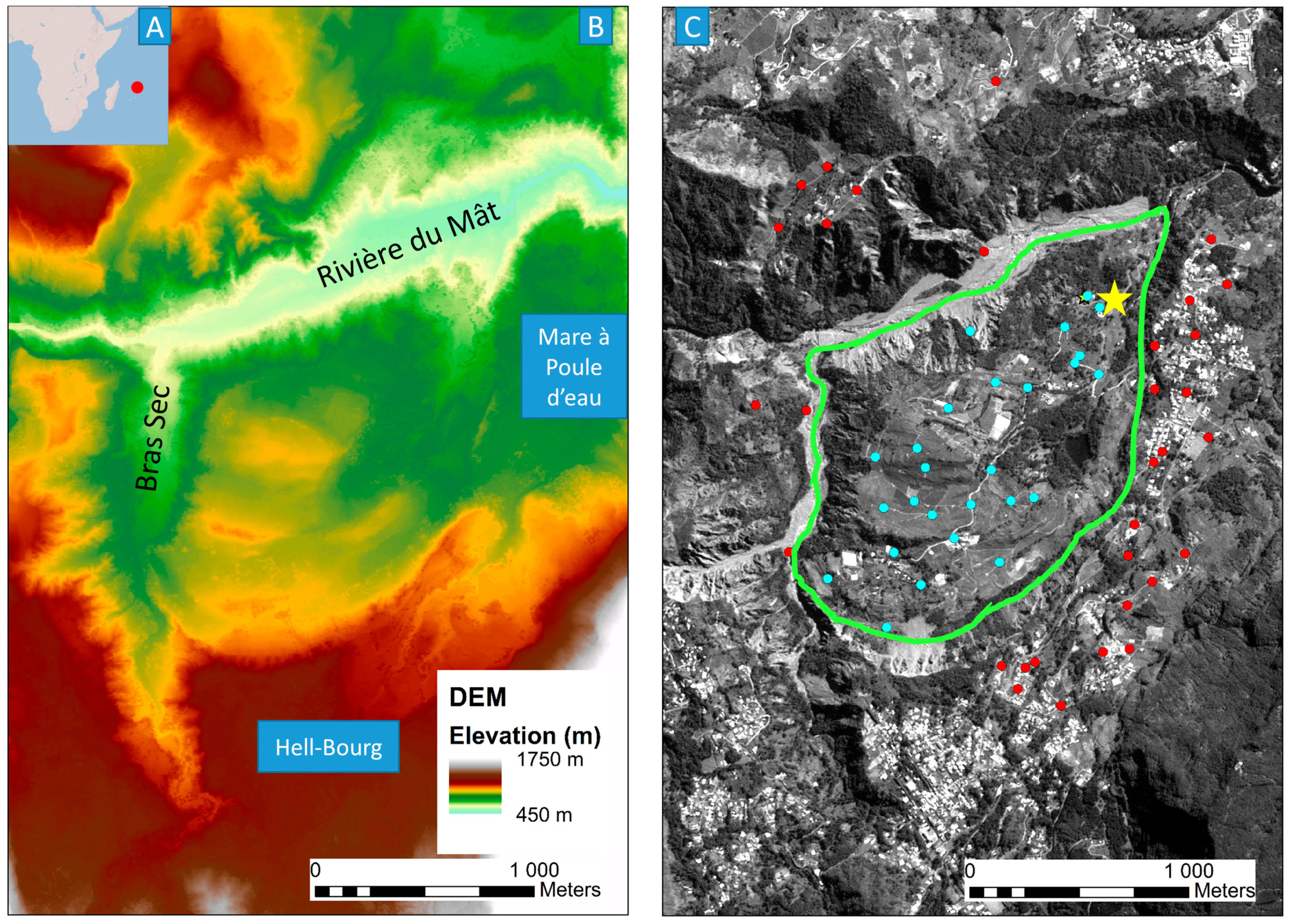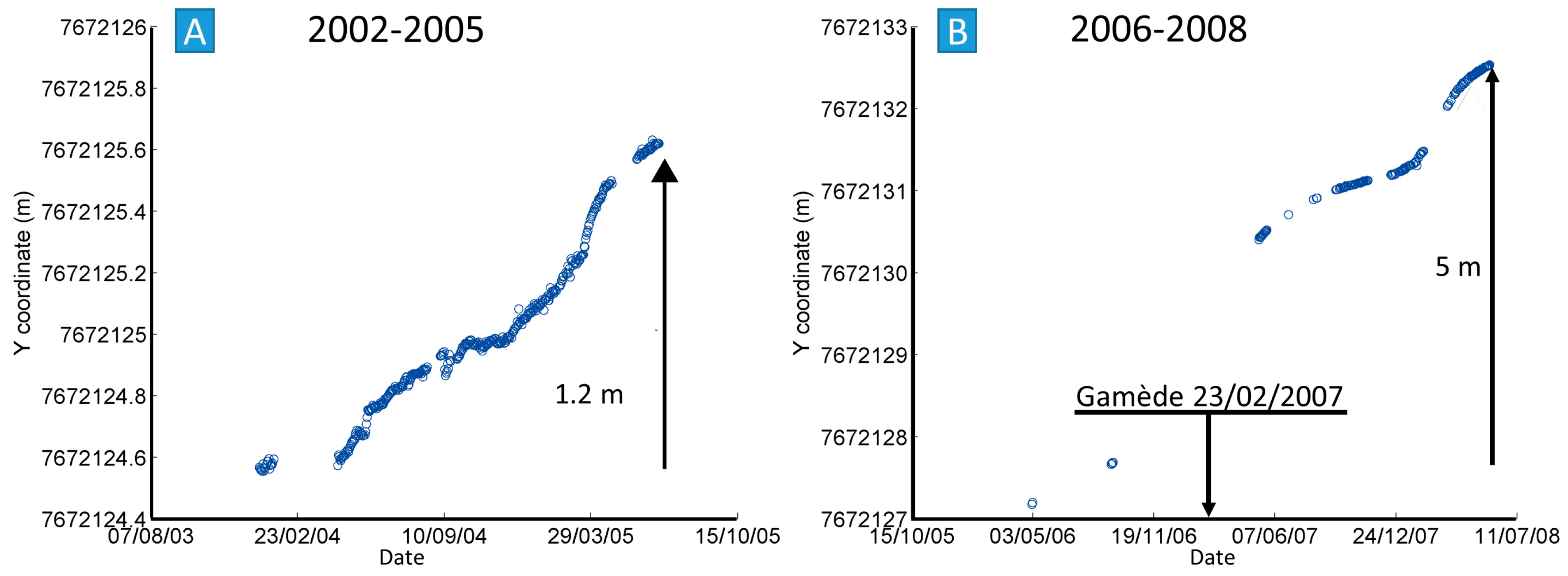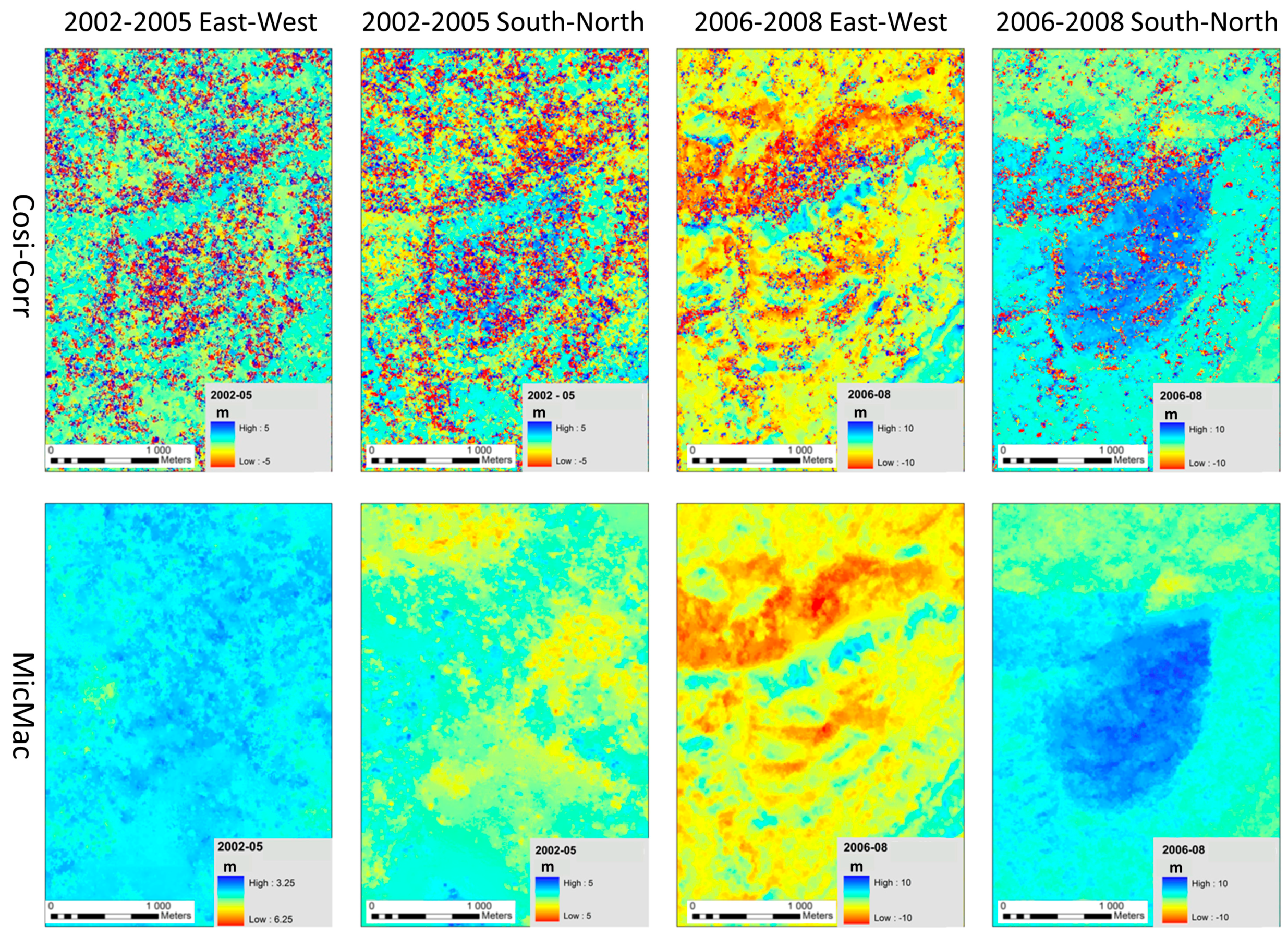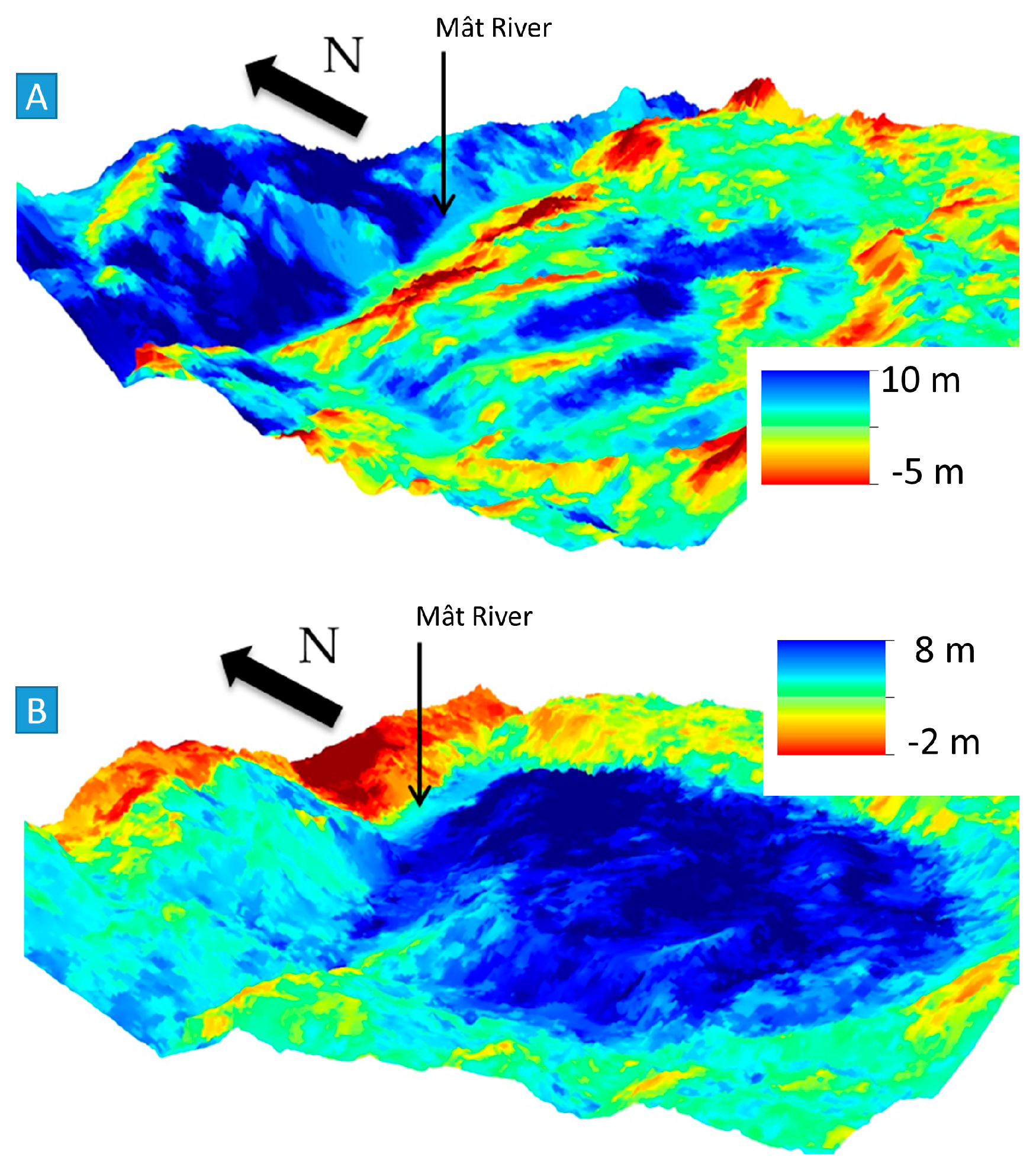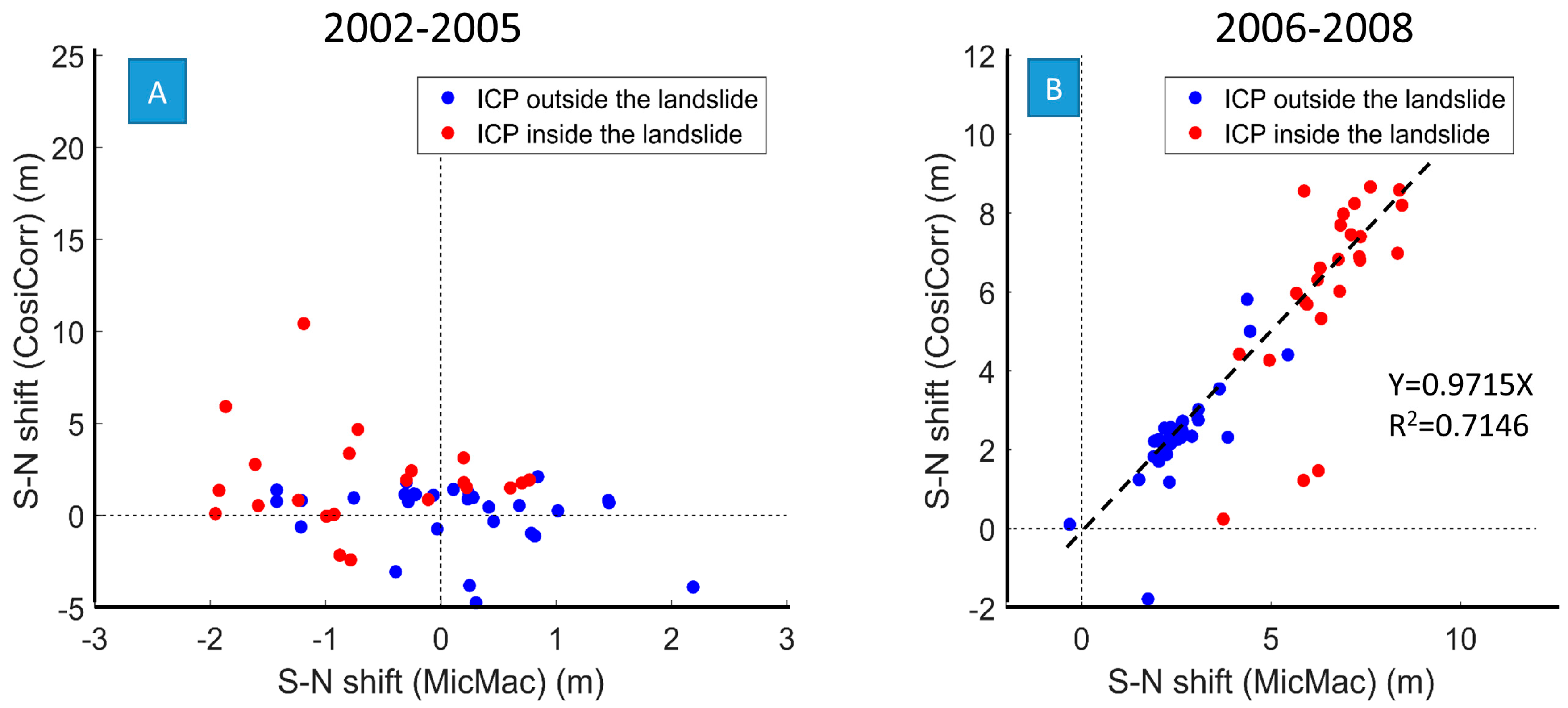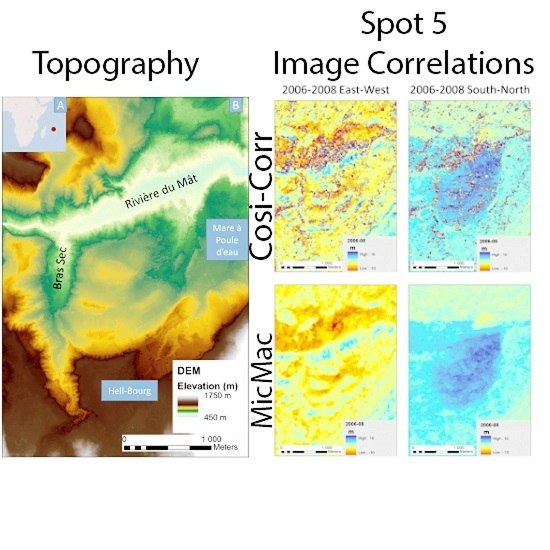1. Introduction
The displacement field of slow to moderate velocity landslides (1.5 m/year < v < 1.5 m/month, [
1]) is a fundamental parameter to measure, for both applied and research purposes [
2,
3,
4,
5]. If followed for a long period of time and coupled with measurements of external parameters such as rainfall or seismic activity, the displacement field can constrain numerical models of landslide evolution [
6,
7] and is also essential for risk mitigation. The techniques used to evaluate the displacement fields of landslides have evolved during the last 30 years. The first measurements were punctual and realized using tachometers. These methods were expensive and also extremely costly because of the number of measurements needed. They produced only a sparse cloud of measurements and do not always permit to obtain an overall view of the cinematics of the landslide. In addition, these data can be dangerous to acquire in poorly accessible areas where these techniques are very difficult to implement. They were mainly applied for the monitoring of landslides that presented a risk to human lives and anthropic infrastructures. DGPS techniques were an interesting alternative to ensure the temporal continuity of the measurements at some specific points on the monitored landslides [
8,
9]. Permanent stations were installed on points that needed a continuous monitoring.
A synoptic view of landslide cinematics can be obtained through the use of aerial images, which allow displacement fields to be measured using the available archives [
10]. The time span between two aerial missions realized in a country such as France by the National Geographic Institute (IGN) was not shorter than five to seven years during the last century. This time span was sometimes too long to investigate the cinematics of landslides. The development of new satellite platforms and the enhancement of data resolution opened a new way to study surface changes and displacements on the earth’s surface from both active and passive remote sensing signals. Radar data of ERS tandem mission were the first to be processed by the DinSAR technique to extract the displacement field produced by fault activity, volcanoes, and landslides [
11]. Due to the loss of coherence in mountainous areas, the time baseline between two acquisitions could not exceed a few days. Moreover, a dense vegetation cover prevented the use of these techniques except if a long wave length (L Band) was used. The DinSAR technique produced results with a sensitivity that was a fraction of the wavelength emitted by the radar parallel to the line of sight of the radar signal and could thus be better than 1 cm [
12]. Only one component of displacement is measured. The results cannot be extrapolated to produce maps of 2D or 3D surface displacement. More recently, new techniques of permanent and persistent scatterers have been developed for landslide analyses [
13,
14,
15]. These techniques permit measurement of the displacement of highly reflective points on a long series of radar data limiting the decorrelation effects.
Passive remote sensing data acquired by satellite platforms have been used to measure displacement fields caused by natural phenomena on the Earth surface using techniques of image correlation [
16]. On two images acquired at different times and ortho-rectified (geometrically corrected from the topographic effect), homologous points are detected by correlation methods with a theoretical sensitivity of one-tenth of a pixel [
17,
18].The shift detected between the homologous points on the two images corresponds to the displacement that occurred between the acquisition of the two images. The correlation of ortho-rectified optical images has been applied to measure the co-seismic displacement fields [
19,
20], the displacement of glaciers [
21,
22], of landslides [
23], and of dunes [
24]. One advantage of the image correlation technique is its capability to measure displacements larger than a few pixels on long time baselines. Moreover, image correlation can be applied to data of various origins. Delacourt et al. [
23] showed that it was possible to correlate images acquired by satellites and aerial platforms if well ortho-rectified. The correlation methods work very well in arid environments on poorly vegetated soils on images at medium, high, or very high resolution. Stumpf et al. [
25] showed that the displacement field of a landslide can be measured using 1 m resolution Pléiades images. The result is very sensitive to the quality of the ortho-rectification that required a Digital Elevation Model (DEM) at a resolution close to the resolution of the images.
In the last few years, the amount of remote sensing images of land surfaces that have been acquired by optical sensors on board satellite platforms has exponentially increased. The development of new operational platforms with high resolution capabilities such as Sentinels-2 and Landsat 8 completes the data offer from satellites such as SPOT-6 and -7 or Pléiades and other satellites with high or very high spatial resolution capabilities. Moreover, the distribution data policy has evolved. It is now very easy, cheap, and sometimes free to obtain high resolution ortho-rectified images on any point on Earth. In parallel, large efforts have been made in the scientific community to provide open source image processing software with correlation capabilities such as MicMac (Multi Images Correspondances par Méthodes Automatiques de Corrélation [
26]) or Cosi-Corr (Co-Registration of Optically Sensed Images and Correlation, [
27,
28,
29]). Thus, there is a democratization of data and techniques which were reserved until recently to specialists of image processing. Potential limitations of these correlation techniques applied to remote sensing data have been partially explored [
18]. For an optimal result, it is better to work on bare soils with a series of images acquired with similar incidence angles to avoid the differences in geometries that can be produced by the ortho-rectification process using a DEM at low resolution. The limits and the potential of satellite image correlation in complex environments from images easily accessible on the internet are yet to be explored. We applied two correlation chains (Mic-Mac and Cosi-Corr) to SPOT-five ortho-rectified images diffused by the Kalideos web-platform (
http://kalideos.cnes.fr/) for two periods (2002–2005 and 2006–2008). These 2.5 m resolution images show an active landslide called “Mare à Poule d’Eau” (MAPE) located on the Réunion Island (France) within the Salazie erosion watershed. This 2.5 km
2 landslide moves at around 1 m/year with very high accelerations in the case of high rainfall associated with storms. It has been monitored since 2002 by a permanent DGPS station. The landslide was less active during the 2002–2005 period than during the 2006–2008 period. The two main land uses at the surface of the landslide are cultivated soils and areas covered by a dense tropical forest. A few anthropogenic constructions are visible as well as some asphalted roads and tracks. After a description of the study area in terms of geology and climate, data and methods of correlation are described. The resulting maps of shifts measured from image pair correlation are presented and discussed relative to (1) the measure of shifts of some points estimated by SIFT methods (Scale Invariant Feature Transform) and relative to (2) the value of displacement measured by DGPS. Precision and reliability are finally discussed to propose a frame of the potential and limitation of correlation methods on SPOT-5 images in order to measure displacements in such complex environments.
2. Study Site
The MAPE landslide (
Figure 1) is located in Réunion Island in the Salazie erosion basin. The landslide covers an area of 2.5 km
2 for an estimated volume of approximately 400 × 10
6 m
3 [
30].
This slow-moving landslide (<2 m/year) is a hazard for the two villages of “Hell-Bourg” and “Mare à Poule d’Eau” located at its borders. The landslide extends on about 2 km between the River du Mât to the north and the Hell-Bourg plateau to the south that forms a scarp of 120 m above the landslide. The east-west extent of the landslide is 1.3 km, between the ephemeral river of Bras Sec in the east and the village of “Mare à Poule d’Eau” to the west. To this day, no geophysical data acquisition of the internal structure of the landslide has been conducted. Therefore, the vertical extent of the landslide remains unknown. The landslide body is composed of recent breccia of differentiated volcanic rocks (the “MAPE breccia”, [
31,
32]) overlying a layer of old breccia, which is characterized by alteration and clay facies. This layer plays the role of detachment surface on which the upper mass slides toward the north [
31]. The landslide topography (
Figure 1B) suggests that the landslide displacement has both translational and rotational components [
31,
33]. The landslide can be divided into four or five compartments delimited by scarps visible on the DEM [
30]. The displacement of the landslide has been partly monitored since 2002, using GNSS data from permanent DGPS receivers located on the slipping area. The displacement has a strong component to the north, with an average velocity increasing northward from 0.8 to 1.33 m/year over the period 2005–2011 [
30].
The climate in Réunion Island is characterized by a temporal heterogeneity of rainfall. The dry season runs from June to November. Major rainfalls occur from December to May. Cyclones and storms regularly affect the island during that period. These intense rainfall events lead to an acceleration of the MAPE landslide [
33]. Average annual rainfalls recorded in the Salazie erosion basin are approximately 3 m.
3. Data and Methods
The data used in this study consist of (1) four SPOT-5 images at 2.5 m resolution dating from 2002, 2005, 2006, and 2008 (
Table 1) (2) A series of positions of the Vira DGPS station (
Figure 1C) measured daily by DGPS since 2002 along a south-north axis in UTM 40 S projection and (3) around 60 Image Control Points (ICP) that have been identified on the four SPOT-5 images by the SIFT algorithm [
34] and visually inspected. The SIFT algorithm (Scale Invariant Feature Transform) is an object recognition method based on the use of local invariant features [
34]. The purpose of such a method is to identify homologous points on two images of same object taken in different acquisition conditions (different, cameras, different angles of view, different times, different scales…). The SIFT algorithm is divided in three phases. In the first one, key points are extracted independently on both images by a technique called Difference of Gaussian that searches the structures which disappear under a certain level of blur [
35]. In the second phase, each point is characterized by a descriptor of its local pixel environment. The SIFT descriptors are based on the normalized gradient of grey level. In the last phase, the geometric descriptors of each point are compared on both images to define the most probable homologous points. The quality of point matching is evaluated from the quality of geometric transformation between of the point clouds identified on both images.
The SPOT-5 images have been acquired with an incidence angle of approximately 25° for the oldest set (2002–2005) and with an incidence angle close to 17° for the more recent set (2006–2008). The images were ortho-rectified and projected in UTM40S on WGS84 (level 3) by the Kalideos service (
http://kalideos.cnes.fr/). The images of 2002 to 2005 cover a period of low displacement according to the DGPS located at Vira (
Figure 2). The landslide was not affected by intense rainfall during that period. The period of 2006 to 2008 corresponds to a period of intense landslide activity. A major storm called Gamède hit Réunion in February 2007. Rainfall reached 1096 mm in one day. The DGPS measurements at Vira station (
Figure 2) showed that a displacement of at least 5 m towards the north occurred during the year that followed this extreme event [
30].
Only the south-north component of the displacement measured by DGPS is available. As the east-west component is very low [
30], this work will mainly concern the south-north component of displacement.
The mathematical principles of image correlation have been extensively presented in others studies [
17,
18] and are briefly outlined. The purpose of image correlation is to detect similar pixel organizations or objects on two images acquired in different conditions in order to measure the shift of the homologous pixels between two images. If the two images have been acquired specifically for photogrammetric purposes, the value of the shift will be used to measure the elevation of the point. If the images are diachronic and ortho-rectified, the shift is then a measure of the surface displacement that occurred between the two acquisitions. One window is defined around the point to correlate on one image. A homologous window of the same size is searched on the other image that will maximize a correlation function. The process can be refined to obtain a precision that reaches one-tenth of a pixel in the ideal case [
17,
18] which is 0.25 m for a SPOT-5 image with a 2.5 m resolution. Various correlation functions can be used that can be statistical or defined in the frequency domain after the decomposition of the image signal in its frequency components. The size of the windows is a critical parameter in the correlation process. The precision of correlation increases when the size of the windows decreases but the results are more sensitive to noise. Less noisy results can be obtained with larger windows but with less precision. Rosu et al. [
18] have tested the effect of window size on the precision of the results.
MicMac [
36] is an open source software originally dedicated to photogrammetry. Image correlation being at the core of photogrammetry, a statistical correlation function is proposed from the correlation engine of MicMac. This correlation function uses a multiscale technique with regularization methods which enable working with very small windows without being sensitive to noise assuming a regular displacement and searching the coherency in the data set [
26,
37]. An option permits the retention of only the pixels that present a coefficient of correlation above a give threshold defined by the user. Windows of 9 × 9 pixels have been used in this study. The threshold of the correlation coefficient was set to the default value that is 0.5 as suggested by Rosu et al. [
18]. The outputs consist of three maps, one of the shifts along the rows, one of the shifts along the columns, and one of the correlation coefficients indicative of the quality of the results.
Cosi-Corr [
27,
28,
29] is an add-on to Envi (Harris Geospatial Solutions) developed by the Tectonics Observatory of Caltech. This free add-on is programmed in IDL and available since 2007. The last version was published in 2014. Cosi-Corr can ortho-rectify aerial or satellite images, can compute internal and external parameters of cameras, provides various filters such as non-local mean filters, etc. Cosi-Corr can also correlate images using frequency or statistical correlation functions. It can use multi-size decreasing windows with resampling of data to increase precision if the shift is large. The GUI (Graphical User Interface) of Cosi-Corr is simple. The user has to define the type of correlator and the size of the correlation window. As suggested by Rosu et al. [
18] a square window of 32 pixels was used in this study with a spatial step of one pixel. As with MicMac, Cosi-Corr produces a map of shift along the line, a map of shift along the row and a map of quality of correlation. If the images are georeferenced the shift is expressed in meters.
These two correlation softwares have been used in various cases to estimate the ground displacement from ortho-rectified images. Rosu et al. [
18] tested the two softwares in three different cases (two ground displacements from earthquakes and one dike intrusion). They showed that the regularization methods of MicMac produces smoother results with less noise and permit to use smaller windows and thus could be used to obtain more accurate displacement values.
The results of these methods consist in (1) the value of shift of the ICP by SIFT measured by the difference of coordinates of each ICP on successive images; (2) the value of shift of the ICP estimated by Cosi-Corr and MicMac and (3) the correlation maps produced by Cosi-Corr and MicMac.
5. Discussion
The goal of this work is to evaluate the precision and sensitivity of the methods of image correlation to measure displacements in complex settings from ortho-rectified images produced by National Space Agencies. Four points are discussed: (1) the correlation of the east-west shifts to slopes; (2) the differences and similarities between the MicMac and Cosi-Corr; (3) the conversion of the measured shifts in a reliable value of ground displacements; and (4) the potential and limits of image correlation to measure displacement in complex environment.
As already observed by Delacourt et al. [
23,
38], image correlation of ortho-rectified SPOT images detects shifts in the east-west direction that seems unrelated to displacement. These shifts, mainly visible on the 2006–2008 data set, are strongly correlated to the slope aspect. The north facing scarps are shifted toward the west while the south facing scarps are shifted toward the east. The shift values reach 10 m in both directions. It seems thus impossible to measure a reliable displacement in the east-west direction if this displacement produces a shift lower or equal than the topographic signal that is four pixels for an image at 2.5 m resolution. East-west (E-W) displacement could possibly be estimated better on flat areas. The E-W shift is certainly due to the large difference in resolution between the DEM (resolution of 25 m) used to ortho-rectify the data and the image (resolution of 2.5 m). Moreover, SPOT-5 uses a pushbroom detector oriented in the east-west direction and orthogonal to the platform path. Such technology could introduce distortions in the direction parallel to the sensor orientation. Correlation between displacement and slope values are interpreted as resulting from a low quality of ortho-rectification. The maximum error of ortho-rectification given by Kalideos for the images is ±2 pixels in both directions for every image that is ±10 m with an average close to 0 in both directions and a standard deviation close to 0.5 pixel in y and close to 0.72 in x. The effects of ortho-rectification on the results are first discussed for the 2006–2008 case on which the correlation shows a clear shift signal that can be related to displacement. In the south-north direction, a clear displacement signal is visible by correlation. If a topographic signal exists, it is minor and hidden by the displacement signal. That indicates that the ortho-rectification errors are nil or similar for the two images. In the east-west direction, the existence of a topographic signal in the correlation results that can reach four pixels (10 m) indicates that the ortho-rectification errors are spatially different for the two images. The acquisition geometry of the two images is slightly different (
Table 1). The difference in incidence angle is close to 2°. This difference is certainly at the origin of the differences in ortho-rectification. This is confirmed by the results obtained on the other set of images for which no clear topographic signal is visible in both directions. The incidence angles of these images are very close with a difference of only 0.05° (
Table 1).
MicMac and Cosi-Corr produce similar results in terms of shift maps. The two correlators are able to detect a shift on the landslide area for a given period of high displacement but they are both unable to measure any coherent shift for the period of low displacement. The shifts measured by the two correlators on the ICP are strongly correlated (
R2 > 0.7) except for some points for which the shift signal measured by Cosi-Corr is noisy (
Figure 7). The smooth results produced by MicMac seem unsatisfactory everywhere on the images. For both periods and between two acquisitions, the land-use has locally changed. New constructions have been built and others have disappeared. New roads opened. Moreover, vegetation evolved, scree slopes were modified by transport and erosion of sediments. The boulder organization in the bed of the Mât River changed. It makes sense if a correlator is not able to define homologous points everywhere in such active landscape. The noisy pixels in the Cosi-Corr results indicate the position of pixels that evolved in term of land use between two acquisitions.
The shift of the ICP detected by SIFT can be discussed according their position and the displacement of the landslide. For the period of low displacement (2002–2005), the average shift of the points located outside the landslide is 0.5 m. The shift of the points located in the landslide is slightly higher and reaches 1.6 m. However, the dispersion of the results is high. It seems difficult to extract a significant shift in terms of displacement for such low values. The results produced by both correlators arrive at the same conclusion. The displacement of the landslide for this period is around 1.2 m toward the north measured by DGPS at the Vira station. It seems that the shift is not significant in such context where displacement and pixel size have similar dimension. For the second period, the average shifts of the ICP located outside the landslide is 2 m toward the north. The shift of the points located in the landslide is 8.5 m toward the north. The dispersion of the results is also high in that case. However, the south-north correlation maps clearly draw the landslide boundaries (
Figure 3). The displacement of the landslide measured at the Vira DGPS station for this time period is larger than 5 m. This suggests that the shift is significant in terms of displacement if the displacement exceeds 5 m (approximately two pixels). For the second period, the shift measured by correlators is larger than the displacement measured by DGPS on one point of the landslide. This shift has to be corrected to estimate a displacement. Two methods can be proposed. The first one uses the average shift measured on the stable ICP point. For the 2006–2008 period, the average shift of the ICP is 2 m towards the north. This value can be subtracted from the shift measured by correlators to estimate the displacement. If applied at the position of DGPS, the corrected magnitude of the shift is approximately 6 m, which is more in accordance with the displacement value estimated by DGPS. The second method uses the background shift values measured by the correlator in the vicinity of the landslide. On the image of the south-north shift produced by both correlators, the landslide is surrounded by an area shifted towards the north by approximately 2 m (turquoise belt around the landslide on
Figure 3). This value can be subtracted from the value of the shift measured on the landslide to estimate the displacement. Here again, a value of 6 m can be calculated for the landslide displacement, similar to the displacement measured by DGPS.
This work shows that correlation can be used to evaluate surface displacements of a complex landscape with images ortho-rectified by institutional providers under some conditions. The first one is that the displacement parallel to the direction of the sensor pushbroom has to be large enough that distortion produced during acquisition and ortho-rectification is negligible. In this study, a shift of ±10 m independent of displacement can be observed. This shift of four pixels represents 1/2.5 of the resolution of the DEM used for ortho-rectification. The second condition is that the displacement in the south-north direction has to be larger or at least equal to two pixels (5 m in the present study). Lower values of shift will be more difficult to detect and attribute to a reliable surface displacement. A good practice to estimate the quality of the results and to correct the shifts to measure displacements is to define some tenths of ICP (60 in our example) spread out all over the image on both stable and displaced surfaces. These ICP will be selected by SIFT and inspected visually to remove or correct the false points. Firstly, the shift values of the ICP will be used to evaluate the validity of the correlation. If the shift measured on points located outside and inside the displaced surface cannot be distinguished, the correlation will give insignificant results. Secondly, if the two categories of points can be distinguished the average shift value of the stable points will be used to correct the shift values of the displaced areas and to estimate their displacement.
The complexity of the study case results from at least four major conditions. The area is covered by vegetation both natural and cultivated that evolve with time. The area is also occupied by human buildings and infrastructures that can appear or disappear on successive images. The third difficulty is related to the high relief of the area which induces planimetric errors in the ortho-images if the satellite images are not taken exactly under the same incidence angle. The last difficulty is that the displacement is in the same order of magnitude as the size of the pixel. In simpler cases, the technique proposed in this study will give better results. On desert areas without evolving vegetation or evolving anthropic constructions the correlation software will produce less outliers and less noise than in the study case presented in this work. If the area is flat, in the case of study of displacement related to an earthquake, the errors of ortho-rectification will be minimum and will allow the use of images taken under different incidence angles. Finally, if the displacement is large compared to the pixel size, the correlation results will be more reliable.
